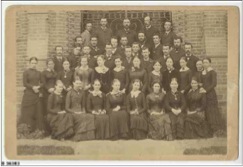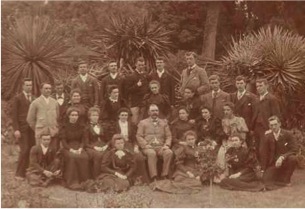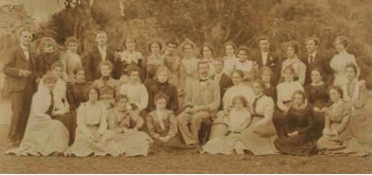Pupil teachers were introduced into South Australia to remedy a growing shortage of teachers for government subsidised schools as the colony expanded during a period of increasing prosperity in the early 1870s. It also needed to introduce its own teacher training system to ensure both future and immediate supply of teachers to meet the demand. In 1873, the Central Board of Education, then responsible for licensing teachers for these schools, turned to the expedient used in England and other Australian colonies for dealing with these issues in the most efficient and cost effective way, by using trainees as a part of the teaching force.
Apprenticing and training potential teachers
From 1874, candidates for teaching entered an apprenticeship agreement that bound them for four years under firm control and with meagre remuneration for the dual task demanded of them. The Education Act of 1875 added further measures of control to the new system, applying them to all public schools of the new Education Department.
Candidates had to be no less than 14 years of age, of good character, healthy and physically fit for the work of teaching. After passing an entrance examination based on the final year of primary school, they entered the First Class of the apprenticeship. Further promotion depended on passing the annual examinations, obtaining successful teaching assessments and receiving a satisfactory report from the head teacher on diligence and conduct. Head teachers were responsible for the instruction of their pupil teachers for one hour before school and for providing a systematic course of home lessons for an hour in the evenings. The latter prepared them for the annual examinations, success in which earned their supervisors a bonus payment. The syllabus for the examinations provided no more than a grounding in the primary school subjects together with advice on how to teach them. In 1876 a Training College was established to give further practical experience and an extended range of school focused subjects.. Some thirty places were to be available but the number of pupil teachers who reached this level depended very much on both the finances available and the staffing needs in the schools each year.

Figure 1: The elite of pupil teachers who made it to the Training College, 1883. State Library of SA, B36383
The pupil teachers and their allocation to schools
Some 75 percent of these pupil teachers were females for whom fewer alternative jobs were available. They received lower pay than males, were required to resign on marriage and attracted other forms of discrimination that set the role of women in teaching apart from men to the disadvantage of the former. Different treatment applied to the length training, subjects studied, levels taught and promotion opportunities.
The allocation of pupil teachers to schools depended on enrolments. In 1876 the City Model Schools, for example, with 787 pupils and a staff of four head teachers and seven assistants, was allocated 17 pupil teachers while a small school such as Strathalbyn received one pupil teacher to assist the head teacher with 62 students. Details of actual class responsibilities are available only in the second set of Pupil Teacher Registers but it is clear from the student numbers involved and what was said about the system that pupil teachers had full and heavy teaching loads during normal school hours which together with study, could involve up to nine hours a day.
Problems with the pupil teacher system
Pupil teachers became a significant part of the teaching force in South Australia, as in other Australian colonies. By 1883 there were 790 teachers and 200 pupil teachers and it was expected that a useful group of sound, practical teachers would eventuate. However, when it came under scrutiny at the Commission of Enquiry into Education in 1882, it was evident that a number of serious faults had developed. The demands of the dual role, teacher and pupil, were onerous. The pupil teachers were generally far too young and ill-educated for the responsibilities thrust upon them. Pupil teachers were being overworked to the point of strain, ill-health and lack of recreation due to the pressure of preparing for and passing the examinations while also teaching. Others were concerned that untrained and immature young people were teaching at too early an age, without the requisite knowledge and skills, and at the expense of their students’ educations. While it was generally accepted that it would be better to first study the art of teaching before being put before a class, it was also recognised that in view of limited finances and lack of adult teachers, the public education system would not survive without pupil teachers. The 1882 Commission found enough support to be able to report that:
We consider that pupil teachers should be retained as part of the school staff. We regard the training they receive during the course as a valuable means of qualifying them to become efficient teachers. In this view we are supported by the Principal of the Training College, and by most of the head masters of our Model Schools. We also recommend that monitors be appointed when pupil teachers cannot be obtained.
Monitors, who were employed in teaching at an even lower salary than a pupil teacher while preparing for the entrance examination, eventually increased in numbers. Over the period to 1899, together with pupil teachers, they formed some 20 percent of the untrained and semi-trained teaching staff in South Australian schools.
The problems outlined by critics continued, and even before the report was published the Principal of the Training College revised his support for the system. In view of the unsatisfactory standard of some of the pupil teachers arriving at the College, he stated that ‘It is evident that their true position—pupil and teacher—has not been always understood, and the former sacrificed in the interests of the latter’ and added that until proper time for instruction and fair time for study was provided, he saw little hope of improvement.
The effect of sacrificing study time to allow for maximum assistance with teaching helped lead, for example, to a high failure rate in the period, especially in the first two classes. The comments of the examiners published in the Education Gazette reveal a good deal about the quality of instruction and supervision as well as the preparedness and application to study of some pupil teachers. From time to time, Inspector-General Hartley reminded head masters of their duty in providing proper instruction and treatment to ensure that pupil teachers felt that they were being helped to become efficient teachers. He also provided practical help to pupil teachers by publishing detailed subject advice in the Education Gazette as well as taking a Saturday morning class himself to prepare pupil teachers for the arithmetic examination.

Figure 2: The training college class of 1894. State Library of SA, B17538
Very many pupil teachers failed to complete the course. Of the sixty-two beginning in 1894, for example, just twenty-three remained for the fourth year. The Pupil Teacher Registers show details of the progress of each pupil teacher. Some completed the four years and went on to the Training College, but others resigned or accepted an early school posting, probably for personal, financial or departmental reasons. Others were dismissed or simply left.
Improving the system: the first attempt
By the early 1890s it was evident that the work of pupil teachers had to be reorganised, but with South Australia entering a period of economic depression it was unlikely that substantial reform would occur. Pupil teachers were sent to the Training School for two afternoons per week from 1896 but this was no substitute for a satisfactory balance between study and teaching.
Unexpectedly powerful voices within the University of Adelaide intervened. Concern over the poor standard of teacher training saw the Council of the University in 1898 decide to use part of the bequest to the University of Sir Thomas Elder in an offer to take over the Training College and undertake responsibility for the training of teachers in public schools. A two year course would include access to university studies free of any cost to government. In so doing, the University would provide a ‘beneficial influence over every child in South Australia through the medium of public schools’. The University also determined that pupil teachers should study for the Senior Public examinations in place of the culturally restrictive Education Department examinations.
It was an offer that was too good for the government to refuse but as there were no Government secondary schools other than the Advanced School for Girls, a way had to be found to free pupil teachers to prepare for the public examinations. This had to occur while the continued with some teaching, seen as necessary for their apprenticeships, as well as essential staffing of schools. From 1900, a new structure provided for all these aspects. The apprenticeship remained at four years, the first two ‘Grades’ being spent as pupils at the new Pupil Teachers’ School, the next two as teachers in schools. As a result, some of the most criticized features of the old system such as beginning teaching too young were removed. The training period became six years with the final two being served as student teachers at the new University Training College. There were high expectations that secondary and tertiary education would provide the literary and cultural depth that had been missing in the former system.

Figure 3: The first students of the University Training College, 1900. State Library of South Australia, B72675
The separate Pupil Teachers’ School began with 48 pupils, a head master and one assistant teacher. As it increased in size and complexity it began to fail the high expectations held for it. Two years proved insufficient time for many pupils to complete the Senior Public. Another problem was the responsibility of the head master in preparing pupil teachers for the teaching period to follow. Additional subjects and lessons were added to the school’s curriculum for this purpose together with one morning a week for observation in local schools. The school was also required to cater for government exhibition holders, to provide Saturday classes for pupil teachers of Grades Three and Four and correspondence lessons for country pupil teachers, all of this with a staff of just four assistant teachers. The Pupil Teachers’ School had too much to do in too short a time. Pupils and teachers became stressed by the workloads and examination results were unsatisfactory. As the numbers who failed to pass the Senior Public increased, the University Training College complained of pupils, even those who passed with the required five Senior Public subjects, as being unprepared for university studies.
Apart from the professional preparation now available at the Pupil Teachers’ School, little had changed for the practical teaching years. Pupil teachers of Third and Fourth Grades were required to teach during the whole of ordinary school hours and head masters had to instruct them in approved modes of teaching for one hour each morning. Those who had not completed the Senior Public were expected to do so either at Saturday classes at the Pupil Teachers School or in their own school. Those who had could attend evening classes at the University. These pupil teachers in the schools remained overloaded. At least they were two years older and had had two years of professional tuition, if limited, in preparation for teaching.
The University Training College faced two problems that brought the opportunity for a university education for teachers to an end within less than ten years. The first related to the lack of preparedness at the secondary level. The resultant stress and high failure rate, even in subjects especially designed for teachers, led to a questioning of the value of a university education for all teachers. The second problem was that the College was not able to provide the professional and practical training that would prepare its graduates for the realities of the classroom in the one hour a week and post examination school visits provided for the purpose. This led to serious misgivings about the efficiency of the University College as a teacher training institution. Subjects such as Education and Psychology, came to be regarded as of little immediate value in terms of professional readiness for the classroom. Headmasters and administrators expected that beginning teachers needed to be able handle a class, not just from theory but from recent practice. They expected teachers to have a detailed knowledge of how to pass subject content on to their classes. The failure of the University Training College to fulfil these expectations proved to be its downfall.
Improving the system: the second attempt
A catalyst for another change was the publication in 1904 of the report of a Commission on Education in New South Wales (Knibbs and Turner) which called for a radical change in teacher education. In his presidential address to the S.A. Teachers’ Union in 1904, Alfred Williams, future SA Director of Education, argued the Commissioners’ view that a university education in Arts was not a proper substitute for the professional education required for teaching. Further reform was needed in South Australia.
In 1906 Williams was appointed Director of Education. He had a mandate to restructure the teacher training system. He believed that in all training two aspects must be kept clearly in view: the cultural and the professional. Practical training should be linked with professional studies that would ensure that student teachers learnt what he termed ‘the art of teaching’. He wanted to change to an effective system that would produce teachers with requisite academic and professional knowledge, together with the skills to apply it. In his view the University scheme of training had never been complete. It lacked an essential aspect, training on the practical side under expert supervision.

Figure 4: Replacing the Pupil Teacher School. A high proportion of Adelaide High School students were ‘junior’ teachers, 1912. State Library of South Australia, PRG 280/1/44/412
Williams went overseas in early 1907 to study training systems in various countries. On return he put forward a new plan. It provided for four grades, the first three of which were for general preparation for the public examinations at the newly established Adelaide High School which replaced the Pupil Teachers’ School in 1908. The fourth year was for practical teaching experience and completing academic qualifications. One year at the University Training College, devoted to mainly professional subjects combined with practical teaching and limited access to such university subjects as Education, completed the new structure which Williams saw as supplying South Australia with a body of well-informed, well-trained teachers. The name of the trainee changed to ‘junior teacher’ and the University Training College became the ‘Teachers Training College’.
Significance of the reforms
Overall, the new system in place by 1913 ensured that beginning teachers had a sound secondary education and were much better prepared for the rigours of the classroom. The reduction of practical teaching to this one year was a major step towards the abolition of the ‘learning to teach by teaching’ apprenticeship model of training that had put such unfair demands on untrained and immature ‘apprentices’. What had been lost, though, was the opportunity for a University degree, especially for infant and primary teachers whose status, pay and even promotion opportunities suffered for many years in comparison with those selected for secondary teaching. In 1921 the junior teacher system itself was virtually abolished, only to be revived in 1931 when financial problems and teacher shortages yet again forced a return to the use of untrained junior teachers in classrooms.
It appears that the basic principles put forward in favour of the training of pupil teachers and junior teachers were not dissimilar to those being promoted in Australia today. Nevertheless the case against the pupil teacher system has cast a heavy shadow. A consequence is that pupil teachers appear as little more than a footnote in South Australian educational history. By losing knowledge of this history we lose significant perspectives on the current debates about the balance between theory and practice in teacher education. How prepared beginning teachers should be remains an issue of contention, as are decisions about staffing shortages in some subject areas and disadvantaged schools where substantially untrained persons are expected to complete their professional training after appointment, while they teach, albeit under better supervision than that accorded to most pupil teachers. It may be that some insights and sharpened questions about these and other contemporary issues might emerge from better balanced accounts of the period marked by a strong attachment to extended practical experience within schools.
